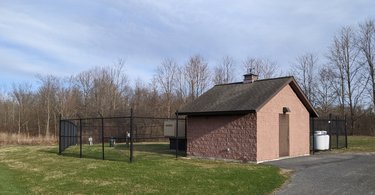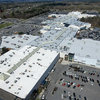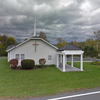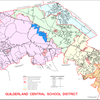Altamont seeks grants to connect to Guilderland water
ALTAMONT — As the only municipality in Albany County not connected to a neighboring watersource, the village of Altamont is now attempting to remedy one of its two major water problems.
The board of trustees on May 6 authorized its engineering firm, Barton and Loguidice, to begin applying for grants — a process that requires, in some instances, that the village also begin bonding the project — to help offset the multi-million-dollar cost of running a line a mile or more from the intersection of routes 146 and 158 to connect Guilderland town water to the village.
The village has a waterline that terminates at Armstrong Drive, approximately three-quarters of a mile from the village line.
While the interconnect will solve Altamont’s longtime problem of not having an emergency backup watersource, it doesn’t appear to solve the multi-year problem the village has had at its Brandle Road wellsite.
In February 2022, Altamont was notified that a sample from the wellsite contained 0.59 milligrams of manganese per liter; the maximum contaminant level allowed by the EPA is 0.3 milligrams per liter. The village shut down the wellsite soon after; when operating, it produces about a third of Altamont’s drinking water supply, but has largely been closed save for periods of peak usage, at which point the Brandle Road supply gets mixed into the village’s other water supply, from Gun Club Road.
Last year, village engineer Rich Straut recommended that Altamont study the introduction of potassium ferrate into the drinking water at the Brandle Road site. The village board approved $20,000 for the pilot study.
The potassium ferrate, Straut told the board a few months later, “was very effective.” But “where we are today,” Straut told trustees, “is that the chemical formulation that we’re looking at is still not commercialized,” which remains true today.
On May 6, Straut was back before the board members to present them with the findings of Barton and Loguidice’s latest study, which was specifically designed to meet the requirements for New York State Environmental Facilities Corporation grant funding.
The three options the study looked at were:
— Potassium ferrate
At approximately $1.1 million, introducing potassium ferrate to the water supply was by far the least expensive of the three options — however, the chemical blend is not commercially available.
This choice would necessitate a relatively small addition to the existing building at the well site. It would also involve the installation of specific filtration equipment and specialized chemical feed apparatus required for utilizing the potassium ferrate;
— Greensand filtration
A greensand filter uses a unique filter coated with manganese dioxide to remove the contaminants from the water. The filter consists of coated sand particles that create an effective platform for the chemical reaction to take place.
This more traditional treatment method carries the highest estimated capital cost, projected at approximately $5.7 million. Implementing the greensand filtration system would involve the construction of a larger building to accommodate the necessary equipment; it would also require the installation of larger filters in addition to the backwashed water needing to be pumped into the village’s sewer system; and
— Connection to Guilderland
The $4.7 million interconnection with the Guilderland town system would require the installation of a transmission line and construction of a pump station near Phillips Hardware, at the intersection of routes 146 and 158. The proposed route — along Route 146 — would include several stream and highway crossings, elements that contribute to the overall cost, Straut noted.
At the May 6 meeting, Mayor Kerry Dineen characterized the Guilderland connection as seemingly the “only choice” given the practical limitations of the other alternatives and the urgent need for an emergency backup, and with the village nearing its source capacity.
Mayor’s view
In an emailed response to Enterprise questions, Dineen said the village board has two issues it needs to address:
— Establishing an emergency interconnect with Guilderland to safeguard the Altamont community, as well as the village’s outside water customers, in the case of any water emergency; and
— Addressing the manganese issues with the Brandle Road wellsite so it can be used on a regular basis, and rotating with Gun Club Road’s wells.
“Although two of the three options addressed the Brandle Road well issue, one option is not currently available to us and the other had a significantly higher price point,” Dineen wrote. “The Village Board felt that the emergency transmission line would be the best option to pursue during this grant cycle.
“Although the Gun Club Rd well is most active, the Brandle Road well is still in use. The interconnect is not meant as a permanent substitute for that site, it would be to provide relief in emergency situations such as drought, water quality issues, or mechanical failure.
“Regarding the Brandle Rd well, unfortunately, the Potassium Ferrate solution is still not commercially accessible. There is no timeframe at this point for its availability. Once it is available, the Village Board can address pursuing that plan of action separately.”
Dineen concluded, “It’s important to know that water interconnects with neighboring municipalities are essential to safeguard communities on both ends of the line. I believe Altamont is the only one, or one of very few, in our County that does not have an interconnect with another municipality. The Town of Guilderland is connected to Albany, New Scotland, Voorheesville, and Rotterdam. It is essential that the Village has the same safeguards in place as all of our surrounding communities and connecting with our own Town seems long overdue.”
“Green belt”
At the May 6 meeting, David Bourque, president of Historic Altamont, raised the issue that connecting to Guilderland water would likely increase development in Altamont, leading to suburban sprawl.
“We all know waters are lifeblood. Got to have it. But I’m not sure if anybody is aware, but the Guilderland bike plan has a connector plan for Guilderland Center to Altamont, and that is to run north of 146, but not along 146. So a water pipe corridor could also dovetail with the Guilderland bike plan where they call for a gravel path,” Bourque told trustees. “And I would also ask that every connection which, of course, is necessary and needed be planned very, very carefully because a water main is like an interstate highway exit. Intensive development follows that.”
He continued, “And what makes Altamont so special and unique is that we are a rural village out here, and we wouldn’t want suburbs of Guilderland becoming Altamont.”
The not-for-profit Historic Altamont is trying to preserve a “green belt” around the Victorian village.
Similarly, the committee that spent two years coming up with recommendations to update Guilderland’s comprehensive land-use plan suggested keeping Altamont as a distinct village.
Historic Altamont also strongly supports town planner Kenneth Kovalchik’s application to the state’s Department of Environmental Conservation for a conservation overlay district to protect the Helderberg viewshed.
“We’re hoping to get DEC support for that,” Supervisor Peter Barber said in March of an overlay district to protect the Helderberg viewshed, “and they will provide us with an attorney and consultants. But, regardless of whether that happens or not, we’re still going to go forward with a conservation overlay district. We already set up the committee.”



